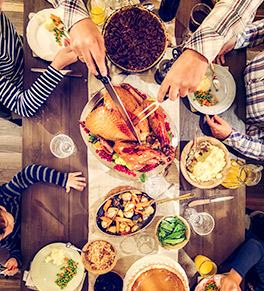Is it heartburn or GERD?

After partaking in Thanksgiving turkey, stuffing, mashed potatoes and gravy, not to mention creamy side dishes and pumpkin pie, many of us will have the uncomfortable sensation of heartburn, or acid reflux.
For some people, heartburn is more than an occasional nuisance after an indulgent meal. Chronic heartburn may be an indicator for gastroesophageal reflux disease (GERD), a condition that can lead to pre-cancerous Barrett's esophagus or esophageal cancer.
Other common symptoms of GERD may include:
- Sour stomach
- Nausea
- Soreness or a lump in the throat
- Food regurgitation
- Bad breath
Heartburn occurs when stomach acid is pushed back into the esophagus, causing pain and irritation. It happens when the esophageal sphincter — a band of muscle that connects the esophagus to the stomach — is weakened or relaxes improperly.
GERD is more than a nuisance, though. When the esophagus is chronically irritated, other more serious conditions can develop, such as Barrett’s.
Prolonged exposure to stomach acids can change the cellular structure of the esophageal lining, putting Barrett’s sufferers at increased risk for a type of cancer called esophageal adenocarcinoma. Between 5% and 10% of GERD sufferers can develop pre-cancerous Barrett’s esophagus.
This makes managing GERD especially important.
What causes GERD?
It’s not fully understood why some people get GERD and others don’t, says UCI Health gastroenterologist Dr. Kenneth Chang.
In some cases, genetics may play a role. “I’ve seen families with GERD generation after generation,” says Chang, executive director of the UCI Health Digestive Health Institute (DHI).
It’s also possible that the more a person experiences acid reflux, the more frequent and worse it gets.
Certain conditions may also a role. Conditions that may increase the risk of having GERD include:
- Hiatal hernia
- Obesity
- Pregnancy
- Asthma
- Smoking
- Delayed stomach emptying
Easing the discomfort
Many people take over-the-counter antacids to relieve heartburn. But acid reflux experienced consistently and over a long period of time should be cause for concern.
“If you’re experiencing heartburn more than three times a week for a period of five years, you should get checked by your doctor,” Chang advises.
This is especially true, he says, for white males over age 50 with an high body mass index (BMI) and body fat around the abdomen.
The GERD team at DHI is focused on controlling or eliminating symptoms, with the ultimate goal of preventing esophageal cancer. Controlling or eliminating symptoms may involve antacid medications as well as recommendations for dietary and lifestyle changes. These include:
- Losing weight, if necessary
- Eating smaller meals
- Avoiding food and drinks that worsen symptoms – fried or fatty foods, alcohol, chocolate, mint, garlic, onions and caffeine
- Eating at least three hours before going to bed
- Quitting smoking
When conservative treatments for GERD don’t relieve symptoms, stronger medication and even surgery may be considered.
Fortunately, Chang says, most patients (75% to 80%) respond to medications and lifestyle changes. However, with data showing more potential side effects of antacid medications (including bone fractures among post-menopausal women), patients may seek alternatives.
Patients who want to go beyond long-term medication have several options to choose from, including:
- Laparoscopic Nissen Fundoplication, known as “the wrap,” which involves wrapping the upper part of the stomach around the esophageal sphincter to prevent acid from coming back up.
- LINX®, a magnetic bracelet surgically placed around the esophageal sphincter that lets food into the stomach but blocks acid reflux.
- Incision-less procedures that put a barrier between the esophagus and stomach (TIF® with EsophyX®) or create scar tissue in the esophageal sphincter to strengthen it (Stretta®). Both are performed through the mouth without an incision.
No need to suffer
DHI specialists do all they can to help GERD patients control and alleviate their symptoms.
Besides the innovative procedures offered, the DHI team does a thorough analysis to come up with a personalized treatment approach for each patient.
“We have everything here,” Chang says. “We do physiological testing to find out what type of reflux you have, we look at your whole anatomy and individualize the treatment to your specific situation. If we discover Barrett’s or early-stage cancer, we can take care of that as well. We’re a one-stop-shop, at your service.”
Explore Further
Browse more blog posts by topic.




